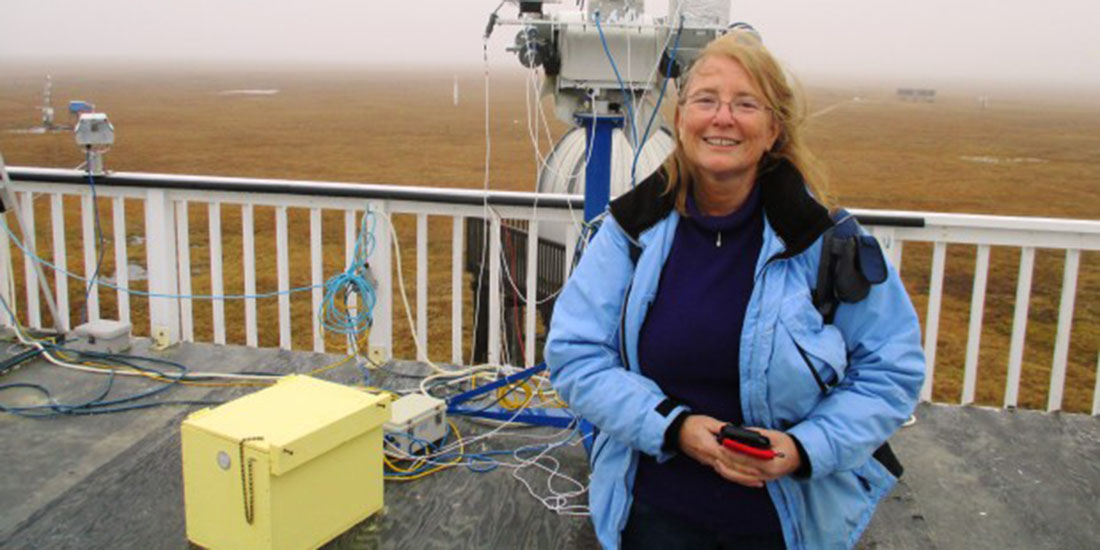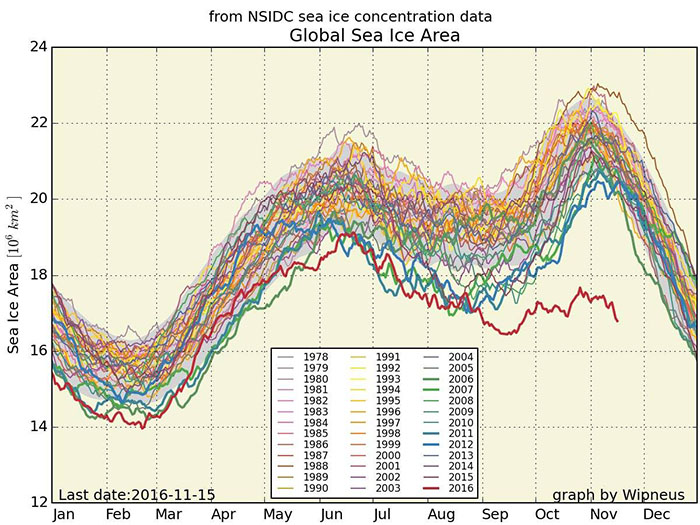 Leslie Field on a research trip to Utqiagvik, Alaska. (Photo courtesy Leslie Field)
Leslie Field on a research trip to Utqiagvik, Alaska. (Photo courtesy Leslie Field)One big reflective band-aid
These days, the to-do list of Leslie Field (M.S.’88, Ph.D.’91 EECS) is dominated by one major item: “I wrote ‘habitable planet’ on my task list,” she says. “Otherwise, my kids are doomed.”
Field remembers the day when she first added the item to her list. It was June 2006, after she attended a documentary screening organized by a fellow parent at her children’s school.
The film was Al Gore’s An Inconvenient Truth, a documentary that explains how increased carbon emissions are fueling a global warming trend with unknown consequences related to weather, economics, health and even geopolitical stability.
“I was devastated after I saw it,” Field says. “I thought, I have a good engineering education — maybe I could develop a technology to deal with climate change.”
The following year, Field began testing ideas to increase the reflective capacity of ice in a small alpine lake in California’s Sierra Nevada. Shortly after, she founded Ice911, a nonprofit organization dedicated to developing systems to be deployed on the planet’s receding ice sheets.
Two years ago, Ice911 set up its first trial site above the Arctic Circle.
A materials challenge
 This graph shows the decline in sea ice over time. (Courtesy Ice911)Field knew from the time that she was about 10 years old that she wanted to be an inventor. When it came time to apply to college, she was torn between pursuing art or engineering. She ended up studying chemical engineering at MIT, earning her bachelor’s and master’s degrees in four years.
This graph shows the decline in sea ice over time. (Courtesy Ice911)Field knew from the time that she was about 10 years old that she wanted to be an inventor. When it came time to apply to college, she was torn between pursuing art or engineering. She ended up studying chemical engineering at MIT, earning her bachelor’s and master’s degrees in four years.
Field then moved to California, where she found a job at Chevron as an R&D engineer, investigating ways to remove lead from gasoline to reduce vehicle emissions that harm health and air quality. But this was in the late 1970s, and the regulatory environment was not ready to embrace new standards for unleaded gas. So Field began looking into Ph.D. programs in electrical engineering.
“When I was shopping for grad schools, I was really impressed that Berkeley would help me schedule a day of interviews with the professors that I would be studying with,” Field says. “I talked to Richard Muller [an electrical engineering professor and founding director of the Berkeley Sensor & Actuator Center] and thought that this would be a great place for a ‘re-tread’ chemical engineer.”
With a second master’s degree and a Ph.D., Field became a project leader at Hewlett Packard, developing technologies that would eventually become known as micro-electro-mechanical systems (MEMS).
In 2001, a corporate restructuring sent Field into consulting work, and eventually back to inventing. Needing a lab and support, she started SmallTech Consulting in 2005, a collaborative of MEMS and nanotechnology researchers and engineers. Field also began teaching a course at Stanford on the intersection of climate change, engineering and entrepreneurship.
A call to action
Much of the focus in past and current analyses of climate change is on carbon emissions as a driver of but another critical factor is energy balance.
The world’s polar ice caps act like giant temperature ballasts because they reflect a great deal of solar radiation back into the atmosphere, thereby keeping the Earth pleasantly habitable. Multi-year ice does a better job at this than new ice, because new ice has less imperfections and that makes it less reflective. Melting polar ice kicks off an ice-albedo (albedo is a measure of how much radiation is reflected) feedback effect, which means as more ice melts, massive areas of reflective surface are lost, speeding up melting and ultimately raising global temperatures and affecting sea levels and global weather patterns.
Last winter, according to NASA, the area covered by Arctic ice hit a record low since scientists first started tracking ice-cap movements by satellite in 1979.
“I thought if I could do something about this, it would be huge,” Field says. “I realized that replacing the layer of reflective ice that is being lost could be approached as a materials challenge.”
After years of testing on sites in California and elsewhere, Ice911’s technology consists of salt-grain sized hollow glass spheres that can boost the reflectivity of existing low-albedo ice. The material is sprinkled on vulnerable ice, and is essentially made of silica, the main component in sand. “It’s embarrassingly simple as a concept,” Field says. “Hollow glass spheres are everywhere — in paints and building materials, basically anywhere there’s a need to make things lightweight and not thermally conductive. Some of them are even bright white. I wanted them to float as well, which turns out to be useful on first-year ice.”
Geoengineering solutions, or altering earth processes in order to slow or halt climate change, are often controversial because they typically require intense tinkering and can be massive undertakings, ranging from changing the acidity of the ocean to creating artificial clouds. Many geoengineering solutions are not reversible and the consequences are unknown, making them potentially a gamble with a large downside risk.
While Ice911’s work falls in the category of geoengineering, Field is adamant that any climate change technology be removable or reversible, and she stresses that slowing Arctic ice melt is not a long-term solution. Instead, it’s triage until more permanent and sustainable long-term climate solutions can be adopted.
“This is just to buy time until we can adopt new energy technologies and become more energy-efficient. If you are going to build a band-aid, then you have to make sure it’s not going to do any harm, and be able to undo it in case there is some kind of unintended side effect,” Field says. “I think we need a much more humble mindset.”
And, given the substantial data showing that Arctic ice is hitting record lows, Field is motivated by a sense of urgency. “Our growing team is working on this as fast as we can, and with hope that this is just in time,” she says.